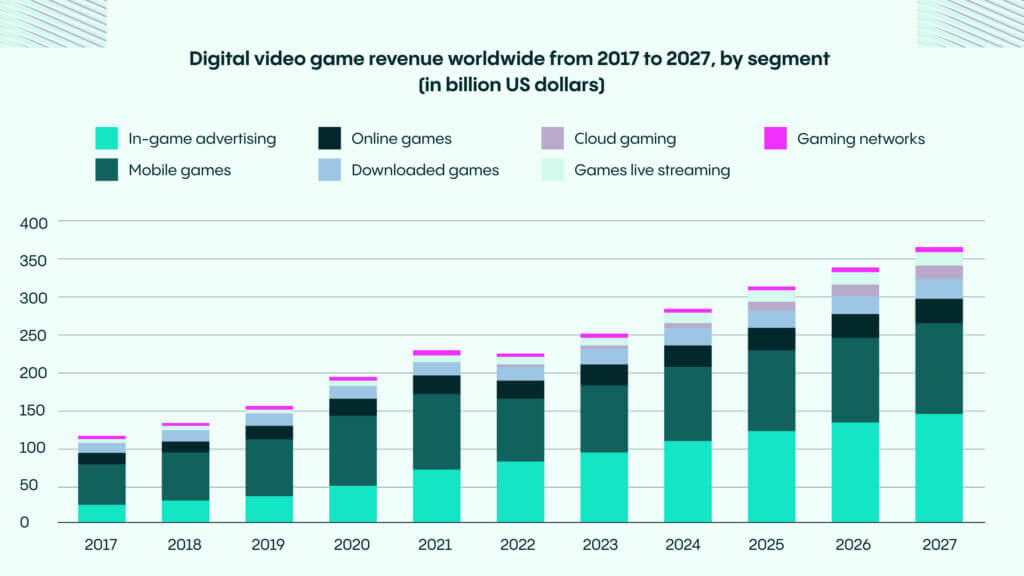Fraud Article
Online games fraud in video-gaming: How to spot, stop, and stay ahead in 2025
In the world of video-gaming, businesses face a particular set of issues, which require a specific solution. In this, the first of a series of blogs, we consider the key problems game providers face – and their consequences.

Introduction
The digital gaming market is thriving, expected to exceed $370 billion by 2027, with the US alone contributing over $140 billion by 2025. As players immerse themselves in stunning visuals and action-packed missions, game publishers and marketplaces battle behind the scenes against a formidable threat: fraud. Gaming has become a near-universal part of teen life — 85% of U.S. teens report playing video games, and 41% say they do so daily, according to a 2024 Pew Research Center study. Gaming is more than just entertainment: it’s a major social channel, with 72% of teen players citing spending time with others as a key reason for gaming, and 47% saying they have made a friend online through games.

Fraud prevention is no longer a cost center — it’s a growth engine. By turning fraud prevention into a proactive strategy, gaming companies can recover lost revenue, boost customer satisfaction, and future-proof operations. Veriff delivers the infrastructure to help platforms approve more legitimate players and stop fraud before it hits the bottom line.
In this blog, we break down the key fraud trends impacting gaming platforms in 2025, show you how to identify threats early, and highlight how proactive fraud strategies drive revenue protection and brand loyalty. Learn how the right fraud prevention approach can turn security into a strategic advantage for your platform.
The hidden threats undermining gaming revenue
Fraud’s two-fold impact
- Financial loss: In 2023, Roblox reported over $110 million in chargebacks. Industry-wide, 10% of all digital gaming transactions are suspected to be fraudulent.
- Customer churn: Rules-based systems incorrectly flag up to 25% of legitimate transactions as fraud. These false positives result in frustrated players — and 40% never return.
Key fraud vectors
- Synthetic Identity fraud: Fraudsters use deepfakes and fake IDs to pass checks.
- Bonus Abuse: Multi-accounting to claim referral rewards.
- Underage fraud: Minors bypass controls using shared or fake credentials.
- Chargeback Abuse: Users exploit refund policies, hitting margins hard.
- Account Takeovers: Stolen credentials give access to stored payment details.
Emerging trend:
According to Veriff’s Identity Fraud Report, online communities, including video gaming, saw a significant proportion of impersonation fraud, with over 90% of all fraud in the vertical attributed to impersonation. While social media platforms continued to see high rates of document fraud, video gaming also experienced a notable increase in document fraud, highlighting the growing sophistication of attacks in this space.

Online communities, including video gaming, saw a significant proportion of impersonation fraud, with over 90% of all fraud in the vertical attributed to impersonation. While social media platforms continued to see high rates of document fraud, video gaming also experienced a notable increase in document fraud, highlighting the growing sophistication of attacks in this space.
AI-powered fraud prevention is the new meta
Adaptive AI in action
Unlike traditional tools, AI-powered fraud systems analyze vast behavioral patterns — from device fingerprinting to how a credit card is typed or pasted. Rather than viewing each purchase in isolation, AI looks for weak signals and recurring anomalies.
For example, if a player uses a new card, copies and pastes payment info, and logs in from a new IP — AI knows these behaviors signal risk. It’s not just one data point, it’s a pattern.
The results of AI-driven defense
- Reduce false positives by up to 90%
- Increase approval rates for genuine users
- Prevent scalable fraud rings before they do damage
AI enables secure, frictionless purchasing — not just reducing fraud, but lifting conversion rates by up to 15%.
How Veriff unlocks revenue and compliance
Veriff goes beyond standard fraud tools. We provide end-to-end identity, fraud, and compliance infrastructure purpose-built for gaming platforms.
Our core products:
- Age Verification & Estimation: Meet compliance needs without slowing onboarding.
- AML Screening & Fraud Intelligence: Identify laundering threats and detect behavioral anomalies.
- Mobile Intelligence & Device Fingerprinting: Stop fraud rings and multi-accounting.
- Biometric Authentication: Ensure returning users are who they say they are.

We help video-gaming companies approve more genuine users and eliminate more fraud, turning trust into a scalable asset.
Global fraud compliance in a dynamic regulatory era
As online gaming grows, so does the scrutiny from regulators. Laws governing age verification, content moderation, and platform responsibility are evolving at different speeds across the globe. The gaming industry faces strict age verification laws to protect minors from accessing age-restricted games or gambling platforms. Non-compliance can lead to significant fines and reputational damage. As gaming platforms expand, implementing robust age verification solutions has become essential for meeting legal requirements and enhancing user safety.
United States
Age verification in the US is becoming a state-level mandate, especially for platforms offering access to “harmful content”—typically games with mature themes such as violence, nudity, or gambling mechanics.
Ad Dmytro Saschuck highlights in this article, under new state-specific laws, operators must verify that players are over 18 before allowing access to certain content. These requirements mirror the regulatory frameworks we’ve seen in industries like adult content and tobacco sales.
Key takeaways:
- Age gates must be enforced before content access — not after registration.
- Self-certification (e.g., “click to confirm age”) is no longer sufficient.
- Gaming platforms targeting minors must comply with COPPA and state-specific privacy laws.
This signals a broader shift toward legally binding age assurance protocols, not just for adult content, but for games with even moderate levels of violence or in-app monetization.
UK & EU
The UK is actively enforcing its Age Appropriate Design Code, also known as the Children’s Code, while the EU is advancing age verification under broader Digital Services Act (DSA) and GDPR frameworks.
“In the EU and UK, it’s not just about confirming a user’s age. It’s about building age-appropriate digital experiences—where underage users are never exposed to harmful mechanics, and platform design defaults to child-safe standards,” says Dmytro Saschuck, commenting on the evolving expectations around online safety in Veriff’s blog on Age Verification in the EU and UKIE. As regulations tighten and platform accountability increases, businesses are expected to go beyond mere compliance and proactively design environments that prioritize the safety and well-being of younger users.
Key takeaways:
- Games must assess and mitigate risk to underage users.
- Platforms are expected to have data minimization strategies—collect only what’s necessary to verify age.
- Fines can be imposed for exposing minors to inappropriate ads, chat features, or loot boxes.
LATAM
Age verification in Latin America is becoming an increasingly urgent topic, as governments begin to confront the rise of harmful content online. While there is no unified regional framework yet, several countries—including Brazil, Mexico, and Colombia— are actively working on legislation focused on protecting minors in the digital space. These efforts primarily target sexual, violent, or psychologically distressing content, meaning enforcement is still highly content-specific rather than platform-wide.
The fragmented regulatory landscape poses challenges, particularly for platforms operating across multiple jurisdictions. However, it also creates opportunities for scalable age verification solutions. Technologies like Veriff’s AI-powered selfie-based age estimation help bridge the gap, especially in regions where users may not have access to official ID documents or where ID checks may be seen as too invasive or premature.
With mobile adoption accelerating and internet access expanding rapidly, LATAM’s digital economy is at a turning point. While the region currently accounts for a smaller share of global gaming revenue, the pressure to regulate is intensifying in tandem with user growth, especially among younger demographics.
Key takeaways:
- Governments in LATAM are pushing for content-specific age verification laws to protect minors.
- Platforms must navigate fragmented regulations across Brazil, Mexico, and Colombia.
- AI-based age estimation offers a scalable solution where ID access is limited.
- Youth-driven digital growth is increasing regulatory pressure on the region’s platforms.
The bottom line — Fraud prevention as a revenue driver
Gaming companies that treat fraud prevention as a growth function unlock:
- Higher player trust and retention
- Lower churn and false-positive rejection rates
- Increased approval rates and faster onboarding
By investing in identity intelligence and adaptive fraud detection, platforms not only protect revenue, they expand it.

Gaming is no longer just about fun and competition — it’s also about responsibility. Our job is to help platforms protect players while meeting complex regulations. That’s where Veriff comes in.

Get more details
Discover more about how IDV is powering video gaming business growth and customer acquisition.














